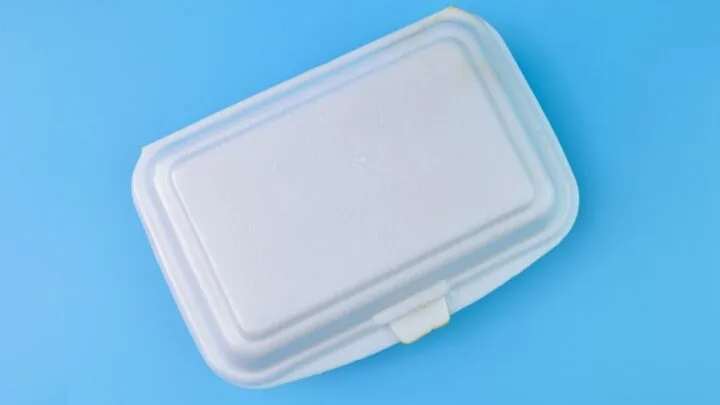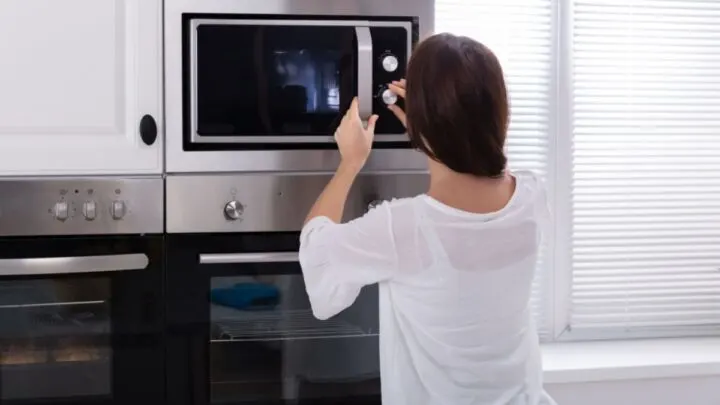Though it is more convenient, not all food containers are appropriate for the microwave, even though it might be easier than putting it on a separate plate.
The containers made of polystyrene foam, also known as Styrofoam, work well to keep the food fresh in the refrigerator but are not designed for the microwave. Upon heating, the chemicals in styrofoam ooze out more quickly, causing many health problems.
Also, at 212 degrees Fahrenheit, the Styrofoam boxes will start to soften, and at 464 degrees Fahrenheit, they will melt completely.
Therefore, you should never use them to reheat the food, and before heating, it is great to move your food in a microwave-safe container.
Let’s look at the construction material of styrofoam to determine why it should not be used in a microwave.

What Is A Styrofoam Material?
Now you know that it is not good to use Styrofoam in the microwave, let’s find out how it is made and why we should not use them.
Styrofoam is formed of polystyrene foam that is used widely to produce disposable containers. Expanded polystyrene foam is poured into molds to create cutlery like plates, cups, and containers.
As they are inexpensive to produce and are great for carrying food, polystyrene containers are a standard yet convenient option in the food sector.
Though it is handier to use, they have many environmental and probable health risks.
These health problems created a growing opposition to disposable polystyrene containers, which outlawed their use in many towns, states, and municipal governments.
Also, the material used in producing Styrofoam-based products has been found to cause cancer in animals and humans.
When styrofoam food containers are microwaved, there is a higher chance of styrene leakage into the meal.
This is particularly true for unhealthy or junk food that contains fat.
Moreover, a styrofoam coffee cup can actually take up to 50 years to degrade. As a result, the harm it causes outweighs the benefits it offers.
Why Can’t We Microwave Styrofoam?
As stated earlier, the polystyrene used in the production of styrofoam cutlery causes harm to human health.
The Food and Drug Administration (FDA) has tested the safety of using plastic and polystyrene cups, dishes, and containers in the microwave to ensure that the level of chemicals that leak out is between 100 and 1000 times lower than the level that has been shown to harm lab animals.
Any container that satisfies the requirement to secrete fewer chemicals upon heating is marked safe to show that it has undergone safety testing.
Therefore, before placing any styrofoam containers in the microwave, you should check the label to see whether it is microwave-safe or not.
Therefore, before placing them in the microwave, you should check out the label to see if it is marked microwave-safe or not.
If they are marked safe, this indicates that it has undergone microwave safety testing, but this isn’t always common.
To keep you and your loved ones safe from any medical concerns, you should resist microwaving meals in polystyrene boxes that are not marked as microwave safe, as their safety cannot otherwise be guaranteed.

In What Way Can I Safely Microwave Food?
Now that you have been aware of microwave-safe products, you must be thinking of some ways to safely microwave your food.
Then don’t worry, here are some tips and tricks to assist you to microwave your food safely:
- The first and foremost thing is to make sure that your container is microwave safe
- You can also transfer your food into a pot or skillet to heat on the stovetop or into a baking dish. If this idea does not suit you, you can also put your food in glass or ceramic or in a pyrex before heating
- Before putting your food in the microwave, look out for potential scratches or fracture, as old or damaged plastic and polystyrene containers could leak hazardous chemicals and should be thrown away at the earliest
- Before heating the container, make some tiny holes in the container. By doing this the pressure won’t build up and would not cause the food in the container to blow
- At last, when your food is completely heated, remove the container with care, and to avoid burning your hands when removing the container after heating your meal, you should wear mittens or gloves.
5 Tips On Microwaving Your Food
Also, here are some additional tips for microwaving your food. This will help you to get your piping hot meal straight out of the oven with care.
- Use parchment, wax paper, or perhaps paper towels to cover the items as they reheat in the microwave
- You should avoid touching food with plastic wrap while using a microwave since it can melt
- Also, move the food to a ceramic or glass container that is labeled microwave-safe if can not confirm that your styrofoam box is microwave safe
- Any container that has been fractured, scratched, or repeatedly microwaved may start to release dangerous plastic into your food
- Though we all know how convenient and tempting it is to utilize those plastic tubs that contain yogurt, mayonnaise, and other foods as additional food storage, they are not made for microwaving and you should not use them
Therefore, with the above-mentioned tips, you should always be cautioned while using food containers in the microwave if you are uncertain of their safety measures.
You may take advantage of the microwave’s heating convenience but for this, you are putting your and your loved one’s health at risk.
Final Words on Putting Styrofoam in the Microwave
In short, you should not use Styrofoam containers, as they can secrete chemicals that can risk your health.
Also, if you still try to heat them despite the danger they cause, the boxes might get cracks, will spill your food and chances are this might cause food to burn.
Therefore, the correct way to reheat your leftovers is to use microwave-safe products.


